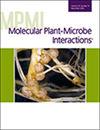求助PDF
{"title":"动态基因对基因的相互作用破坏了持久的抗性。","authors":"Barbara Valent","doi":"10.1094/MPMI-02-25-0022-HH","DOIUrl":null,"url":null,"abstract":"<p><p>Harold Flor's gene-for-gene model explained boom-bust cycles in which resistance (<i>R</i>) genes are deployed in farmers' fields, only to have pathogens overcome resistance by modifying or losing corresponding active avirulence (<i>AVR</i>) genes. Flor understood that host <i>R</i> genes with corresponding low rates of virulence mutation in the pathogen should maintain resistance for longer periods of time. This review focuses on <i>AVR</i> gene dynamics of the haploid Ascomycete fungus <i>Pyricularia oryzae</i>, which causes rice blast disease, a gene-for-gene system with a complex race structure and a very rapid boom-bust cycle due to high rates of <i>AVR</i> gene mutation. Highly mutable blast <i>AVR</i> genes are often characterized by deletion and by movement to new chromosomal locations, implying a loss/regain mechanism in response to <i>R</i> gene deployment. Beyond rice blast, the recent emergence of two serious new blast diseases on wheat and <i>Lolium</i> ryegrasses highlighted the role of <i>AVR</i> genes that act at the host genus level and serve as infection barriers that separate host genus-specialized <i>P. oryzae</i> subpopulations. Wheat and ryegrass blast diseases apparently evolved through sexual crosses involving fungal individuals from five host-adapted subpopulations, with the host jump enabled by the introduction of virulence alleles of key host-specificity <i>AVR</i> genes. Despite identification of wheat <i>AVR</i>/<i>R</i> gene interactions operating at the host genus specificity level, the paucity of effective <i>R</i> genes identified thus far limits control of wheat blast disease. [Formula: see text] Copyright © 2025 The Author(s). This is an open access article distributed under the CC BY-NC-ND 4.0 International license.</p>","PeriodicalId":19009,"journal":{"name":"Molecular Plant-microbe Interactions","volume":"38 2","pages":"104-117"},"PeriodicalIF":3.4000,"publicationDate":"2025-03-01","publicationTypes":"Journal Article","fieldsOfStudy":null,"isOpenAccess":false,"openAccessPdf":"","citationCount":"0","resultStr":"{\"title\":\"Dynamic Gene-for-Gene Interactions Undermine Durable Resistance.\",\"authors\":\"Barbara Valent\",\"doi\":\"10.1094/MPMI-02-25-0022-HH\",\"DOIUrl\":null,\"url\":null,\"abstract\":\"<p><p>Harold Flor's gene-for-gene model explained boom-bust cycles in which resistance (<i>R</i>) genes are deployed in farmers' fields, only to have pathogens overcome resistance by modifying or losing corresponding active avirulence (<i>AVR</i>) genes. Flor understood that host <i>R</i> genes with corresponding low rates of virulence mutation in the pathogen should maintain resistance for longer periods of time. This review focuses on <i>AVR</i> gene dynamics of the haploid Ascomycete fungus <i>Pyricularia oryzae</i>, which causes rice blast disease, a gene-for-gene system with a complex race structure and a very rapid boom-bust cycle due to high rates of <i>AVR</i> gene mutation. Highly mutable blast <i>AVR</i> genes are often characterized by deletion and by movement to new chromosomal locations, implying a loss/regain mechanism in response to <i>R</i> gene deployment. Beyond rice blast, the recent emergence of two serious new blast diseases on wheat and <i>Lolium</i> ryegrasses highlighted the role of <i>AVR</i> genes that act at the host genus level and serve as infection barriers that separate host genus-specialized <i>P. oryzae</i> subpopulations. Wheat and ryegrass blast diseases apparently evolved through sexual crosses involving fungal individuals from five host-adapted subpopulations, with the host jump enabled by the introduction of virulence alleles of key host-specificity <i>AVR</i> genes. Despite identification of wheat <i>AVR</i>/<i>R</i> gene interactions operating at the host genus specificity level, the paucity of effective <i>R</i> genes identified thus far limits control of wheat blast disease. [Formula: see text] Copyright © 2025 The Author(s). This is an open access article distributed under the CC BY-NC-ND 4.0 International license.</p>\",\"PeriodicalId\":19009,\"journal\":{\"name\":\"Molecular Plant-microbe Interactions\",\"volume\":\"38 2\",\"pages\":\"104-117\"},\"PeriodicalIF\":3.4000,\"publicationDate\":\"2025-03-01\",\"publicationTypes\":\"Journal Article\",\"fieldsOfStudy\":null,\"isOpenAccess\":false,\"openAccessPdf\":\"\",\"citationCount\":\"0\",\"resultStr\":null,\"platform\":\"Semanticscholar\",\"paperid\":null,\"PeriodicalName\":\"Molecular Plant-microbe Interactions\",\"FirstCategoryId\":\"99\",\"ListUrlMain\":\"https://doi.org/10.1094/MPMI-02-25-0022-HH\",\"RegionNum\":3,\"RegionCategory\":\"生物学\",\"ArticlePicture\":[],\"TitleCN\":null,\"AbstractTextCN\":null,\"PMCID\":null,\"EPubDate\":\"2025/4/24 0:00:00\",\"PubModel\":\"Epub\",\"JCR\":\"Q2\",\"JCRName\":\"BIOCHEMISTRY & MOLECULAR BIOLOGY\",\"Score\":null,\"Total\":0}","platform":"Semanticscholar","paperid":null,"PeriodicalName":"Molecular Plant-microbe Interactions","FirstCategoryId":"99","ListUrlMain":"https://doi.org/10.1094/MPMI-02-25-0022-HH","RegionNum":3,"RegionCategory":"生物学","ArticlePicture":[],"TitleCN":null,"AbstractTextCN":null,"PMCID":null,"EPubDate":"2025/4/24 0:00:00","PubModel":"Epub","JCR":"Q2","JCRName":"BIOCHEMISTRY & MOLECULAR BIOLOGY","Score":null,"Total":0}
引用次数: 0
引用
批量引用

 求助内容:
求助内容: 应助结果提醒方式:
应助结果提醒方式:


